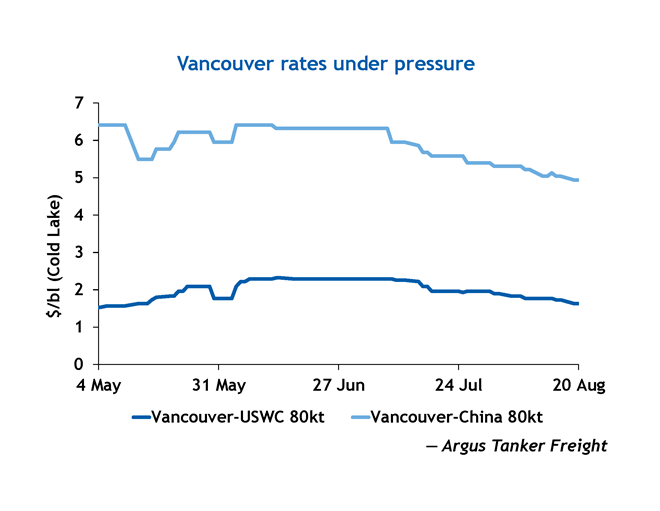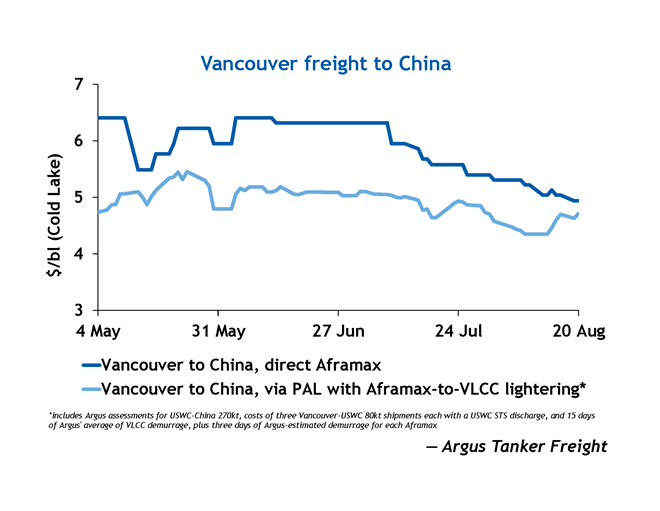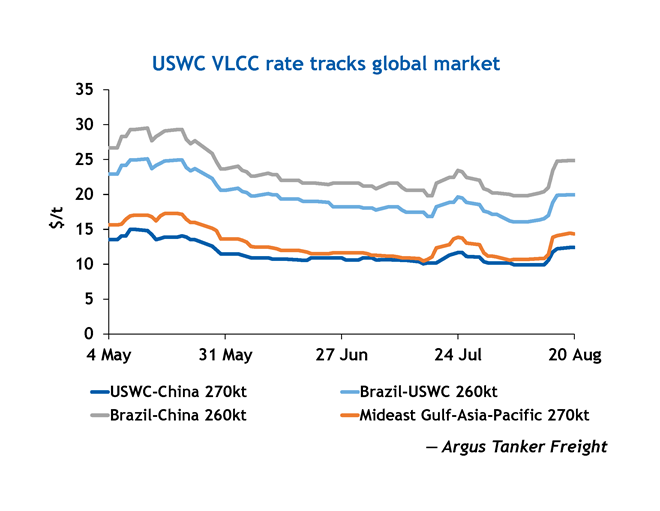The first three months of Canada's Trans Mountain Expansion (TMX) have sent a surge of crude to refiners in California and China, shifting tanker demand in the Pacific basin.
The 590,000 b/d TMX project nearly tripled the capacity of Trans Mountain’s pipeline system to 890,000 b/d when it opened on 1 May, linking Alberta's oil sands to Canada's west coast for direct access to lucrative Pacific Rim markets, where buyers are eager for heavy sour crude.
Between 20 May, when the first TMX cargo began loading, and 20 August, about 165,000 b/d of Vancouver crude exports landed at ports on the US west coast, primarily in California, up from about 30,000 b/d in that same span last year, according to data from analytics firm Kpler.
The freight rate for a Vancouver-US west coast Aframax shipment averaged $1.98/bl for Cold Lake between 1 May and 20 August. This ranged from a low of $1.50/bl from 1-3 May when shipowners repositioned to the region in anticipation of TMX to a high of $2.32/bl from 13-14 June, according to Argus data.

The new oil flow into the US west coast has displaced shipments from farther afield in Ecuador and Saudi Arabia. Crude exports from those countries into the US west coast averaged 110,000 b/d and 25,000 b/d, respectively, between 20 May and 20 August, down from 155,000 b/d and 135,000 b/d over the same stretch in 2023, according to Kpler.
The growth of the Vancouver market, which benefits from its proximity to California, has reduced tonne-miles, a proxy for tanker demand, into the US west coast. This has outpaced slightly lower crude demand, which fell in part due to Phillips 66 halting crude runs at its 115,000 b/d refinery in Rodeo, California, in February to produce renewable fuels, as well as weaker-than-expected road fuel demand this summer.
Tonne-miles for US west coast crude imports fell by 14pc to 106bn between 20 May and 20 August 2024 compared with the same period a year earlier, Vortexa data show, while overall crude imports declined just 8.6pc to 1.37mn b/d, according to Kpler.
PAL-ing around with VLCCs
Though much of Vancouver’s exports have been shipped to the US west coast, Canadian producers have found ready buyers in Asia-Pacific as well, where about 160,000 b/d of Vancouver exports went between 20 May and 20 August, compared with none a year prior, Kpler data show.Buyers and sellers have displayed a preference for using ship-to-ship transfers onto very large crude carriers (VLCCs) at the Pacific Area Lightering zone (PAL) off the coast of southern California, rather than sending Aframaxes directly to refineries in east Asia. Of the 30 Vancouver-origin Aframax cargoes that have landed in China, South Korea and India, 19 were transferred onto VLCCs at PAL, Kpler data show. Seven cargoes were sent directly to east Asia on time-chartered Aframaxes — the majority by Suncor — and just four were sent using spot tonnage, likely due to the expensive economics of trans-Pacific Aframax shipments.
The Vancouver-China Aframax rate between 1 May and 20 August averaged $5.90/bl, with a low of $4.94/bl from 19-20 August and a high of $6.41/bl from 1-10 May and again from 4-12 June, according to Argus data.
Over the same time, the cost to reverse lighter, or transfer, three 550,000 bl shipments of Cold Lake crude from Vancouver onto a VLCC at PAL averaged about $8.055mn lumpsum, or $4.92/bl, with a low of $4.35/bl from 8-13 August and a high of $5.45/bl on 22 May, according to Argus data. This includes $150,000 ship-to-ship transfer costs at PAL, 15 days of VLCC demurrage and three days of Aframax demurrage for each reverse lightering.

VLCC costs could change preferences
Though it may have been cheaper to load TMX crude on VLCCs at PAL since May, volatility in the VLCC market — which often falls to yearly lows in summer before climbing to seasonal highs in the winter — could entice traders to opt for direct Aframax shipments if VLCCs hit their expected peak in the winter.
VLCC costs for shipments from the US west coast to China are influenced by the VLCC markets in the Mideast Gulf and Brazil, where ships look for their next voyage after discharging on the US west coast.

For now, Vancouver-loading Aframax rates are under pressure from the reemergence of VLCCs in what had become an Aframax trade in Thailand, boosting Aframax supply in the Pacific and pulling the class’s rate to ship crude from Vancouver to the US west coast to its lowest level in more than three months on 19 August.
In mid-July, VLCCs resumed discharging via single point mooring (SPM) at Thailand's port of Map Ta Phut for the first time since January 2022, ship-tracking data from Vortexa show. Prior to the SPM's return to service, VLCCs could discharge cargoes only by lightering onto smaller Aframaxes, which would then unload at a different berth in the port.
This created demand for about eight Aframax lighterings each month, but with VLCCs in Thailand again able to discharge directly, that demand is effectively halted, putting downward pressure in the broader southeast Asia Aframax market.
Since July, two Aframaxes have left the southeast Asia market for Vancouver, according to ship tracking data from Kpler: the Eagle Brisbane, which previously was used in lightering operations at Map Ta Phut, and the Blue Sea, which recently hauled fuel oil from nearby Singapore to China.
Spotlight content
Related news
Trinidad not part of US blockade of Venezuela: PM
Trinidad not part of US blockade of Venezuela: PM
Kingston, 19 December (Argus) — Trinidad and Tobago is not involved in the US blockade of oil tankers entering and leaving from neighboring Venezuela, prime minister Kamla Persad-Bissessar said on Thursday. She rejected a Venezuelan government claim that her country is part of US president Donald Trump's current campaign against Venezuelan president Nicolas Maduro, and that it is supporting "the theft of Venezuelan oil." "We have no intention of engaging in any war with Venezuela," Persad-Bissessar said. But Trinidad's foreign ministry said on 15 December that the US is using the country's two airports for "logistical activities," including resupply for US operations and personnel rotations. Venezuelan vice-president Delcy Rodriguez accused Persad-Bissessar of being "hostile" to Venezuela, saying she "has turned her country into a US aircraft carrier to attack Venezuela, in an unequivocal act of vassalage." The US has stationed a large naval force in the waters near Venezuela since September and has destroyed several small boats in the area it said were carrying drugs, killing more than 80 people. Trump said in November he would order land strikes against Venezuela soon, and the US seized a tanker carrying Venezuelan crude earlier this month. Trinidad's rejection of the Venezuelan claims follow a standoff between the hydrocarbon producers over agreements to develop an offshore natural gas field in Venezuelan waters close to their maritime border that has an estimated 4.3 Tcf in reserves. Trinidad described a Venezuelan decision to terminate all natural gas supply contracts with it as "propaganda". The southwestern tip of gas-short Trinidad is 11 miles from Venezuela's north coast, and the country has been seeking gas from Venezuelan offshore fields to support up declining domestic output. By Canute James Send comments and request more information at feedback@argusmedia.com Copyright © 2025. Argus Media group . All rights reserved.
Mexico central bank cuts target rate to 7pc
Mexico central bank cuts target rate to 7pc
Mexico City, 19 December (Argus) — Mexico's central bank cut its benchmark interest rate by 25 basis points to 7pc, its lowest level since June 2022, maintaining a slower pace in the easing cycle on inflation concerns. The decision marked the eighth rate cut this year and the fourth quarter-point reduction following four consecutive half-point cuts. This year's cuts follow five quarter-point cuts in 2024 from a cyclical peak of 11.25pc in March. The board approved the cut in a 4-1 vote, with deputy governor Jonathan Heath dissenting in favor of holding the rate at 7.25pc. Heath has been the lone dissenter in the past five decisions, consistently urging greater caution. The central bank said the decision reflected "the behavior of the exchange rate, the weakness of economic activity and the possible impact of changes in global trade policies," repeating language used in its last four statements. Gabriela Siller, chief economist at Banco Base, pointed to a "significant change" in the bank's forward guidance, noting a shift toward a less dovish tone. The board said it "will consider when to make further adjustments" to the policy rate, replacing the "will consider cutting" language used in November. Mexican bank Banorte also said the central bank struck a less dovish tone, pointing to a change in its forward guidance. Annual inflation rose to 3.8pc in November from 3.57pc in October, according to statistics agency Inegi. Core inflation, which excludes volatile food and energy prices, accelerated to 4.43pc from 4.28pc. The central bank now sees headline inflation ending 2025 at 3.7pc, up from 3.5pc in its November forecast, while core inflation is projected at 4.3pc, revised from 4.1pc. It also raised its headline and core forecasts for the first two quarters of 2026, while maintaining that both will converge to its 3pc target by the third quarter. The bank said the revisions mainly reflect a "more gradual-than-expected" easing in services inflation, along with a smaller contribution from accelerating consumer goods prices. The board also addressed recent tax reforms, which it expects will have a temporary and not necessarily proportional impact on prices, adding it will update its forecasts as it conducts a comprehensive assessment of the revised tax code's effects. By James Young Send comments and request more information at feedback@argusmedia.com Copyright © 2025. Argus Media group . All rights reserved.
US House passes bill to expedite permitting
US House passes bill to expedite permitting
Washington, 18 December (Argus) — The US House of Representatives on Thursday approved a bill designed to fast-track permitting for energy projects and reduce related litigation risks. But a last-minute change Republicans made to exclude some offshore wind and solar projects led some Democrats and a major clean energy group to withdraw support, complicating the bill's chances of passage in the Senate. The Republican-controlled House voted 221-196 to pass the SPEED Act, with 11 Democrats crossing the aisle to vote for what would be the most significant changes to federal permitting in years. The bill will now advance to the US Senate, where proponents will likely need to agree to make significant changes if they hope to pick up the votes of at least seven Democrats to avoid a filibuster. The bill "finally brings common sense by cutting red tape that dramatically increases the cost and, in some cases, just makes it economically unfeasible to do projects", House Republican majority leader Steve Scalise (R-Louisiana) said. The SPEED Act focuses on revising project reviews under the National Environmental Policy Act (NEPA), which is a source of delay and litigation risk for pipelines and renewable projects alike. The bill would require federal agencies to narrow those reviews and uphold those decisions even if federal courts find them to be inadequate. The bill would also provide permit "certainty" by limiting the government's ability to rescind prior approvals, averting a repeat of events like the cancellation of the Keystone XL pipeline. "We applaud the House for advancing the SPEED Act, a bipartisan, commonsense step toward fixing a federal permitting system that's long been broken," oil industry group the American Petroleum Institute said. Republican leaders were hoping 30-40 Democrats would join them to support the SPEED Act. The bill had broad bipartisan support when it was drafted because of provisions meant to prevent permitting delays that have plagued both oil and gas pipelines and renewable energy development. But Republican leaders, to satisfy far-right conservatives, made a change to the bill earlier this week that would prevent its expedited permitting procedures from benefiting any project that Trump's administration has blocked or revisited since 20 January. The Trump administration has targeted multiple offshore wind and solar projects this year and has ordered the developer of the nearly complete 704MW Revolution Wind project off the coast of Rhode Island to stop construction. That change fractured a bipartisan coalition that had spent months working on technology-neutral permitting language. The American Clean Power Association, the largest industry group for US renewable energy, on Wednesday withdrew its support of the bill , arguing the "poison pill amendment" that Republicans made eviscerated bipartisan language that gave expedited permitting treatment for all types of energy resources. A number of House Democrats who had backed the bill also withdrew their support. American Clean Power plans to work with both parties in the Senate to make changes. "This is not the final draft," representative Scott Peters (D-California) said during floor debate Thursday, vowing to work with his colleagues in the Senate to address House Democrats' concerns. By Chris Knight and Haik Gugarats Send comments and request more information at feedback@argusmedia.com Copyright © 2025. Argus Media group . All rights reserved.
Ithaca first to try new UK North Sea regime
Ithaca first to try new UK North Sea regime
London, 18 December (Argus) — UK-listed upstream producer Ithaca Energy has begun the approval process for a development in the North Sea, the first since the government softened its approach to the region. Ithaca has submitted a development summary and environmental statement for the Fotla field to the offshore regulator Opred. It outlines a two-well tie-back to the Britannia platform, which processes liquids from the Greater Britannia Area, including Ithaca's Alder field. Ithaca indicates that if the process is successful, drilling will begin in the first half of 2027, with first oil in the final quarter of that year. This is the first submission of an offshore proposal since the UK government published its 'North Sea Future Plan' alongside its budget in late November. That enables "limited oil and gas production in areas that are already part of an existing field, or in areas adjacent to already licensed fields, linked via a tieback, to help ensure they remain economically viable". Developers are not permitted to explore for oil and gas at these sites, and a ban remains on new oil and gas licensing. London's stance on North Sea development has delayed the Rosebank project, in which Ithaca holds a 20pc stake, and the company's west of Shetland Cambo project. Ithaca expects its production to average 119,000-125,000 b/d of oil equivalent (boe/d) this year. By Ben Winkley Send comments and request more information at feedback@argusmedia.com Copyright © 2025. Argus Media group . All rights reserved.


